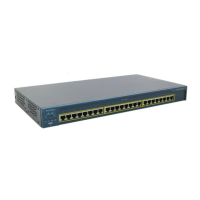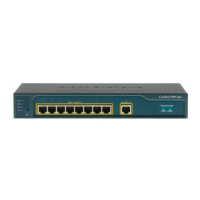9-4
Catalyst 2950 Desktop Switch Software Configuration Guide
78-11380-03
Chapter 9 Configuring STP
Understanding Basic STP Features
• The identifier of the transmitting interface
• Values for the hello, forward delay, and max-age protocol timers
When a switch transmits a BPDU frame, all switches connected to the LAN on which the frame is
transmitted receive the BPDU. When a switch receives a BPDU, it does not forward the frame but instead
uses the information in the frame to calculate a BPDU, and, if the topology changes, initiates a BPDU
transmission.
A BPDU exchange results in these actions:
• One switch is elected as the root switch.
• The shortest distance to the root switch is calculated for each switch based on the path cost.
• A designated switch for each LAN segment is selected. The designated switch is the one closest to
the root switch through which frames are forwarded to the root.
• A root port is selected. This port provides the best path from the switch to the root switch.
• Interfaces included in the spanning-tree instance are selected.
• All interfaces not included in the spanning tree are blocked.
STP Timers
Table 9-1 describes the STP timers that affect the entire spanning-tree performance.
Creating the STP Topology
In Figure 9-1, Switch A is elected as the root switch because the switch priority of all the switches is set
to the default (32768) and Switch A has the lowest MAC address. However, due to traffic patterns,
number of forwarding interfaces, or link types, Switch A might not be the ideal root switch. By
increasing the priority (lowering the numerical value) of the ideal switch so that it becomes the root
switch, you force an STP recalculation to form a new topology with the ideal switch as the root.
Table 9-1 Spanning Tree Protocol Timers
Variable Description
Hello timer Determines how often the switch broadcasts hello messages to other switches.
Forward-delay timer Determines how long each of the listening and learning states last before the interface begins
forwarding.
Maximum-age timer Determines the amount of time the switch stores protocol information received on an interface.

